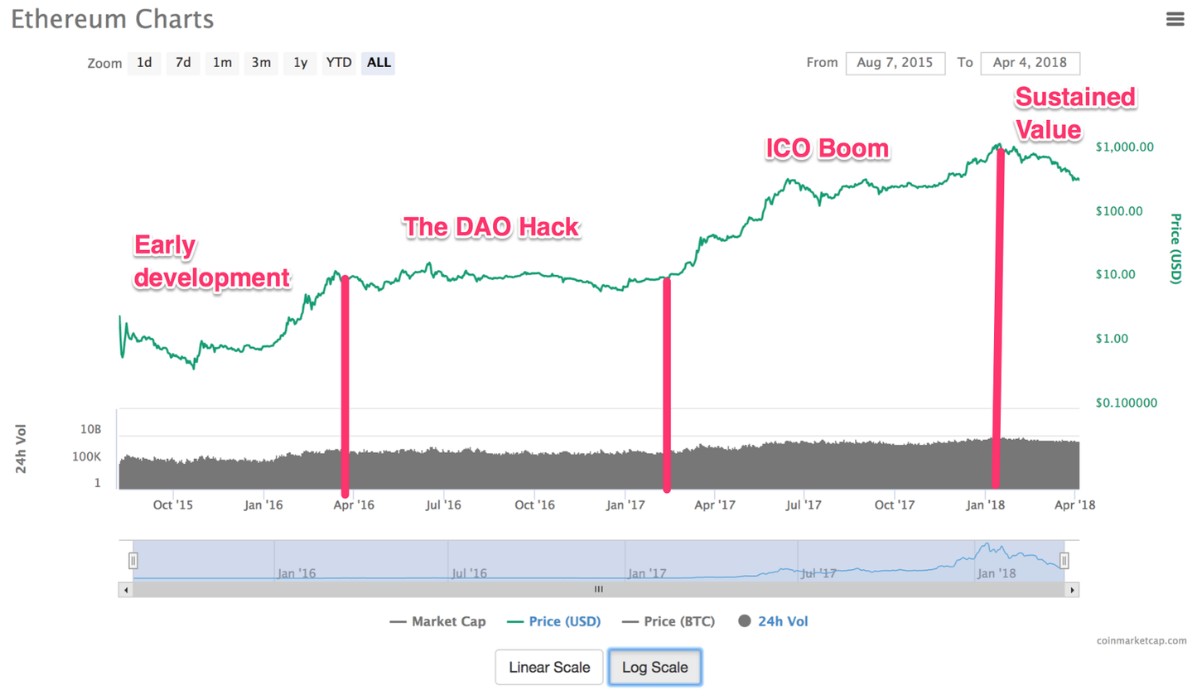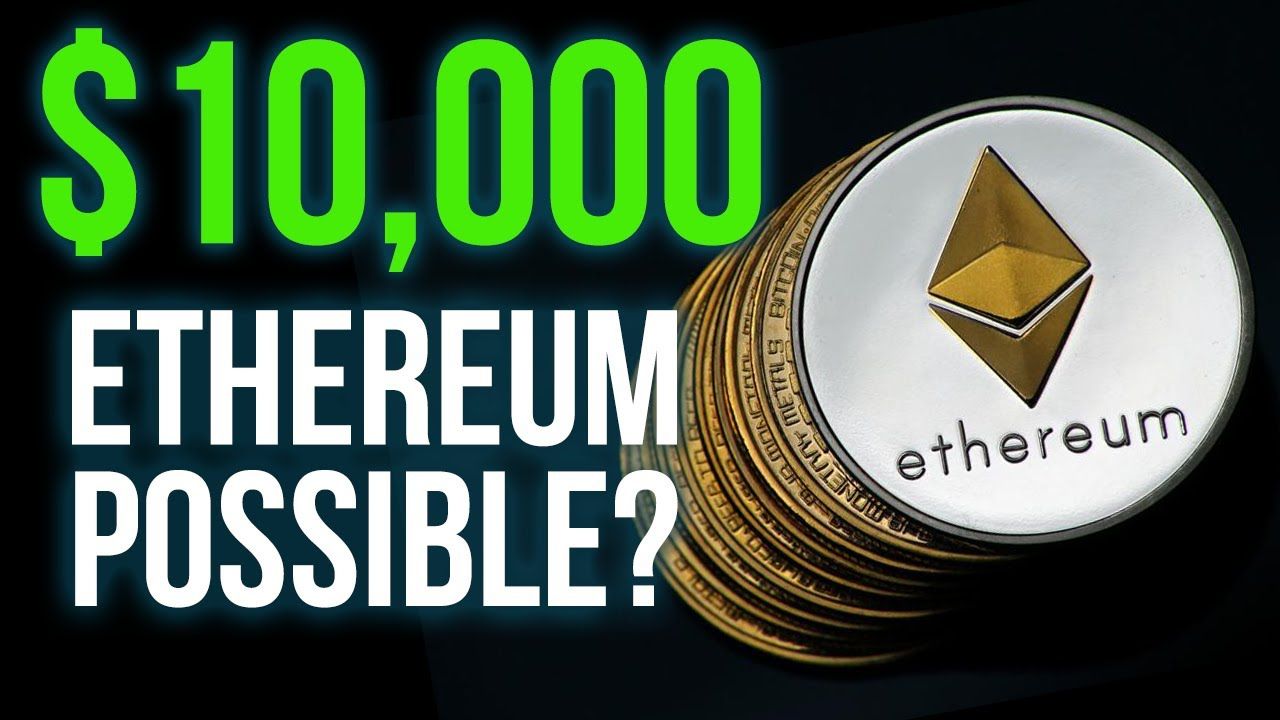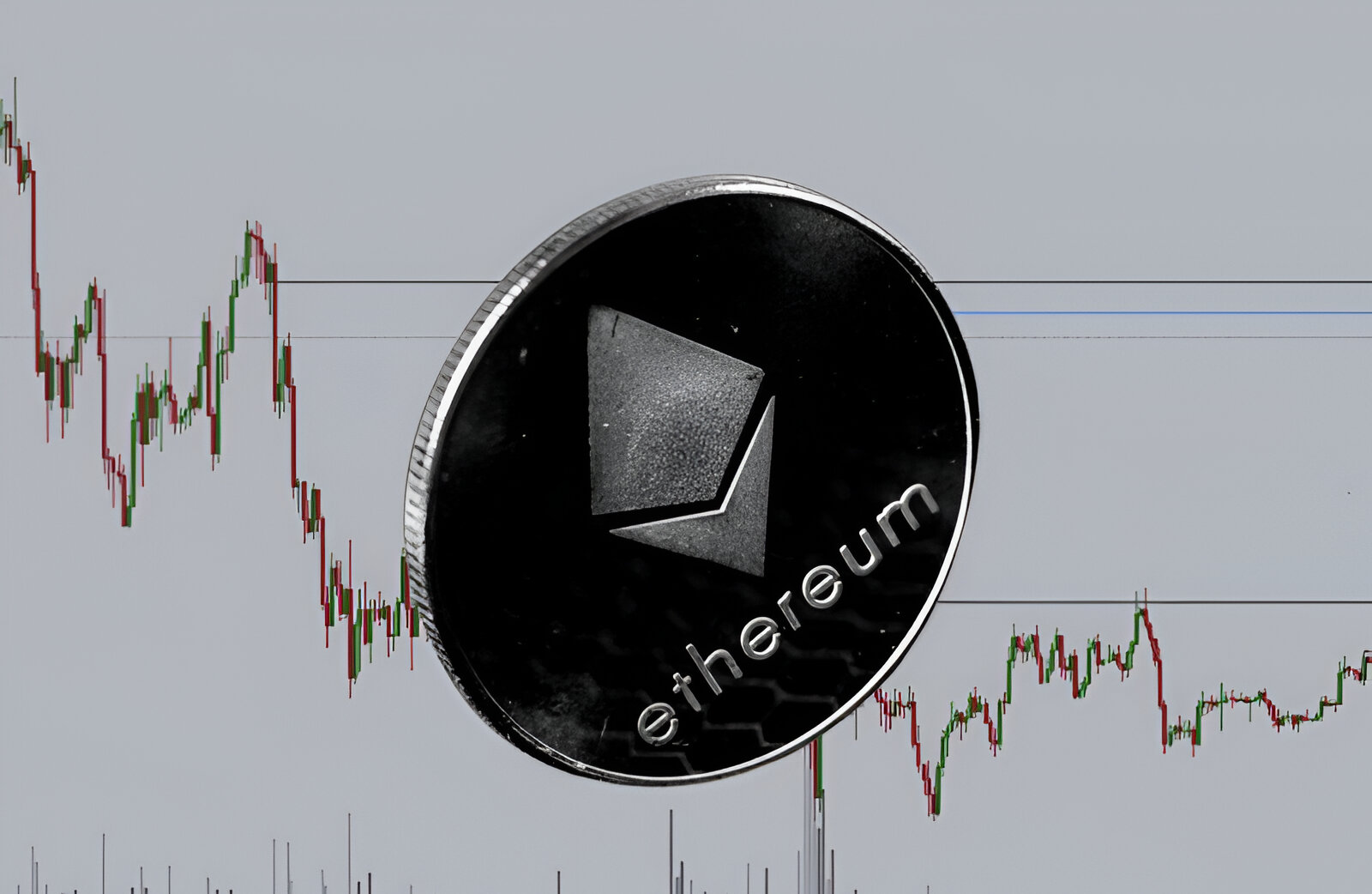Introduction
In the world of cryptocurrencies, Ethereum has emerged as one of the most prominent players. Launched in 2015, Ethereum introduced the concept of smart contracts and decentralization, revolutionizing the blockchain technology landscape. With its own native cryptocurrency called Ether (ETH), Ethereum has garnered immense attention and investment as a decentralized platform for creating and executing programmable applications.
The primary driving force behind the price of Ethereum can be attributed to a multitude of factors. These factors range from basic supply and demand dynamics to market sentiment, technological developments, integration and adoption, competition, regulatory environment, and overall economic conditions.
Understanding these key drivers is crucial for investors, traders, and enthusiasts who closely follow the Ethereum market. By gaining insights into these factors, one can better gauge the potential price movements and make more informed decisions.
In this article, we will delve into each of these important drivers and explore how they impact the price of Ethereum.
The Basics of Ethereum
To understand what drives the price of Ethereum, it’s important to have a grasp of the fundamental concepts behind this innovative platform. Ethereum is a decentralized blockchain platform that enables developers to build and execute smart contracts and decentralized applications (DApps).
At the core of Ethereum is its native cryptocurrency, Ether (ETH). ETH serves as the fuel for executing transactions and running applications on the Ethereum network. It is also used to incentivize miners who validate and secure the network.
Ethereum differentiates itself from other cryptocurrencies, like Bitcoin, by introducing the concept of smart contracts. These self-executing contracts automatically enforce the agreed-upon terms between parties without the need for intermediaries. Smart contracts have diverse use cases, ranging from financial services and supply chain management to decentralized finance (DeFi) and gaming.
Another key aspect of Ethereum is its scalability and upgradeability. While the current version, Ethereum 1.0, has faced challenges with high transaction fees and network congestion, the upcoming Ethereum 2.0 upgrade aims to address these issues through a shift from Proof-of-Work (PoW) to Proof-of-Stake (PoS) consensus mechanism. This upgrade is expected to improve transaction speed and reduce fees, making Ethereum even more attractive to users and developers.
The Ethereum community is vibrant and dynamic, with a large number of developers contributing to its ecosystem. Ethereum has also gained significant attention in the mainstream financial industry, with major corporations and institutions exploring its potential. This increased adoption and interest contribute to the overall market sentiment surrounding Ethereum.
Overall, Ethereum is a versatile and groundbreaking platform that has sparked innovation and disruption across various industries. Its features like smart contracts, scalability, and widespread adoption make it a driving force in the crypto space and play a crucial role in influencing its price.
Supply and Demand
The basic economic principle of supply and demand significantly influences the price of Ethereum. The supply of ETH is limited, with a total maximum supply set at 18 million ETH per year. This scarcity, combined with increasing demand, can drive the price upwards.
The demand for Ethereum stems from various sources. Firstly, developers and businesses require ETH to pay for transaction fees and execute smart contracts on the Ethereum network. As the number of DApps and users utilizing the Ethereum ecosystem increases, the demand for ETH as a utility token grows.
Additionally, investor demand plays a crucial role in driving the price of Ethereum. Many individuals and institutions are attracted to the potential for high returns offered by cryptocurrencies. As Ethereum continues to gain recognition and adoption, more investors are seeking to purchase ETH as a speculative asset, contributing to the overall demand.
Supply, on the other hand, is influenced by the Ethereum network’s protocol. The issuance of new ETH is determined by a combination of mining rewards and inflation. Miners receive newly minted ETH as a reward for validating transactions and securing the network. However, with the transition to Ethereum 2.0’s Proof-of-Stake, the issuance of new ETH will be reduced, potentially creating a supply shortage and driving the price upwards.
Other factors that impact the supply and demand dynamics of Ethereum include market sentiment, technological developments, and regulatory changes. Positive news and advancements in the Ethereum ecosystem, such as the launch of significant upgrades or partnerships with influential companies, can increase demand for ETH. Conversely, negative events or unfavorable regulatory actions can dampen demand and affect the price negatively.
Understanding the balance between supply and demand is essential for predicting potential price movements of Ethereum. Increases in demand and limited supply can result in price surges, while a decrease in demand or increased supply can lead to price declines.
Market Sentiment
Market sentiment refers to the overall emotional and psychological attitude of investors and traders towards a particular asset—in this case, Ethereum. It plays a crucial role in shaping the price of Ethereum, as it reflects the collective optimism or pessimism of market participants.
Positive market sentiment can drive the price of Ethereum higher. When investors perceive Ethereum as a promising and valuable asset, they are more likely to buy and hold ETH, leading to increased demand. Positive news such as partnerships, technological advancements, institutional adoption, or regulatory clarity can contribute to positive sentiment and drive up the price.
Conversely, negative market sentiment can have a detrimental impact on the price of Ethereum. Factors such as security breaches, regulatory concerns, market volatility, or negative media coverage can create fear and uncertainty among investors. This can lead to selling pressure, causing the price of Ethereum to decline.
Market sentiment can also be influenced by external factors such as global economic conditions, market trends, or the overall performance of the cryptocurrency market. Sudden market downturns or bearish trends can result in a pessimistic outlook for Ethereum, impacting its price.
Social media platforms, online communities, and cryptocurrency news outlets play a significant role in shaping market sentiment. The opinions and sentiments expressed by influential individuals and groups can sway the sentiment of the broader market. FOMO (Fear of Missing Out) and FUD (Fear, Uncertainty, and Doubt) can also contribute to shifts in market sentiment as investors react to perceived opportunities or risks.
It is important for investors and traders to closely monitor market sentiment and its impact on the price of Ethereum. By staying informed about market trends, news, and the overall investor sentiment, one can make more informed decisions and potentially capitalize on the shifts in market sentiment.
Technology and Development
The continuous advancement of Ethereum’s technology and development is a significant driver of its price. As a decentralized platform, Ethereum constantly strives to improve its infrastructure, scalability, and functionality, which directly impacts its value in the market.
One of the key developments in Ethereum’s ecosystem is the upcoming Ethereum 2.0 upgrade. This upgrade aims to address the scalability challenges faced by Ethereum 1.0 by transitioning from the energy-intensive Proof-of-Work (PoW) consensus mechanism to the more energy-efficient Proof-of-Stake (PoS) consensus mechanism. The shift to PoS will allow Ethereum to process transactions faster, reduce fees, and improve overall network efficiency. Anticipation and positive sentiment surrounding this upgrade can contribute to an increase in the price of Ethereum.
Additionally, the development of new and innovative applications on the Ethereum platform can drive up its value. Ethereum’s ability to support smart contracts and decentralized applications (DApps) has attracted a vast community of developers and entrepreneurs. As new projects are launched and gain traction, they contribute to the growth and adoption of Ethereum, which positively impacts its price.
Interoperability and integration with other blockchain platforms is another important aspect that can impact Ethereum’s price. Collaboration and compatibility with other blockchain networks can unlock new opportunities and expand Ethereum’s user base. Cross-chain solutions and interoperability protocols can enhance Ethereum’s utility, attract more users, and ultimately increase its value.
Furthermore, any vulnerabilities or security breaches discovered within the Ethereum ecosystem can significantly impact its price. The discovery of critical bugs or hacking incidents can erode investor confidence and lead to a decline in the price of Ethereum. Conversely, proactive security measures and audits can enhance trust and positively influence its value.
Regular updates, bug fixes, and enhancements to the Ethereum network also play a role in price determination. Ethereum’s development team, along with the wider community, work tirelessly to maintain and improve the platform’s stability, security, and functionality. These ongoing improvements contribute to investor confidence and can drive the price of Ethereum higher.
Overall, the technology and development efforts surrounding Ethereum are crucial factors that influence its price. Upgrades, innovations, security measures, and collaborations shape the perception of Ethereum in the market, ultimately impacting its value and long-term viability.
Integration and Adoption
Integration and adoption are key drivers of Ethereum’s price, as they determine the level of utilization and acceptance of the platform in real-world applications. The extent to which Ethereum is adopted by individuals, businesses, and institutions plays a significant role in influencing its value in the market.
One area where Ethereum has gained significant traction is in the field of decentralized finance (DeFi). DeFi applications built on the Ethereum platform provide users with financial services such as lending, borrowing, and decentralized trading. The growth of the DeFi ecosystem has resulted in a surge in demand for Ethereum, as it is the primary currency used in most DeFi protocols. Increased integration of Ethereum into DeFi platforms and the continued development of innovative DeFi applications contribute to the positive sentiment and potential price appreciation of Ethereum.
Enterprise adoption of Ethereum is another factor that impacts its price. Large corporations and institutions are increasingly exploring the potential of blockchain technology, and Ethereum has emerged as a preferred platform for building private and consortium blockchains. Collaborations and partnerships between Ethereum and established companies can lead to increased usage and demand for ETH, ultimately driving its price upwards.
Furthermore, the integration of Ethereum into traditional financial systems and infrastructure is a significant indicator of its growing acceptance. Financial institutions, such as banks and asset management firms, are exploring ways to leverage Ethereum’s technology to streamline processes and offer new financial products and services. Increased utilization of Ethereum in the traditional finance sector can increase demand for ETH and positively impact its price.
Integration and adoption within the gaming and non-fungible token (NFT) space are also contributing factors to Ethereum’s price. Ethereum’s ability to support unique digital assets and enable decentralized marketplaces has made it a popular choice for NFT projects and gaming applications. As more players and developers enter the Ethereum gaming ecosystem, the demand for ETH as in-game currency and for purchasing exclusive digital assets can increase, leading to price appreciation.
Moreover, government recognition and regulation of Ethereum can influence its adoption and value. Clear regulatory frameworks that support cryptocurrency and blockchain technology can foster trust and encourage more widespread adoption of Ethereum. Conversely, restrictive regulations or regulatory uncertainties can hamper adoption and negatively impact its price.
In summary, the level of integration and adoption of Ethereum in various sectors, including DeFi, enterprise applications, traditional finance, gaming, and government recognition, are instrumental in determining its price. The more Ethereum is embraced and utilized in real-world applications, the higher its value is likely to be in the market.
Competition
Competition within the cryptocurrency market is a crucial factor that influences the price of Ethereum. As a prominent player, Ethereum faces competition from other blockchain platforms that offer similar functionalities or cater to specific use cases.
One of the primary competitors of Ethereum is Binance Smart Chain (BSC). BSC offers a fast and low-cost alternative for executing smart contracts, appealing to users who prioritize transaction speed and cost efficiency. The growing popularity of BSC has created a competitive landscape, as developers and users weigh the advantages and disadvantages of each platform. Shifts in user preferences and adoption rates between Ethereum and BSC can impact the demand and price of ETH.
Other blockchain platforms, such as Cardano, Polkadot, and Solana, also pose competition to Ethereum. These platforms aim to address scalability and interoperability challenges faced by Ethereum and offer unique features and capabilities. The success and adoption of these competing platforms can influence investor sentiment toward Ethereum and potentially impact its market value.
In addition to blockchain platforms, stablecoins pose competition to Ethereum’s native cryptocurrency, Ether. Stablecoins, such as Tether (USDT) and USD Coin (USDC), provide users with a stable value alternative for conducting transactions and storing value. The increased usage of stablecoins can indirectly impact the demand for Ether, as users may choose to hold stablecoins instead of Ether for transactional purposes.
Furthermore, competition also arises in the form of other decentralized platforms for building and executing smart contracts. Platforms like EOS, Tron, and Neo offer alternatives to Ethereum, each with their own unique features and capabilities. The success and adoption of these platforms can divert developer attention and user adoption away from Ethereum, potentially impacting its price.
It is worth noting that competition within the cryptocurrency market is not necessarily a zero-sum game. The growth and success of competing platforms can drive innovation and advancement in the blockchain industry as a whole. However, understanding the competitive landscape and how Ethereum positions itself against its rivals is crucial for assessing its market value and potential price movements.
Regulatory Environment
The regulatory environment surrounding cryptocurrencies, including Ethereum, plays a significant role in shaping its price. As governments and regulatory bodies seek to establish frameworks for digital assets, changes in regulations can impact the adoption, perception, and value of Ethereum in the market.
Positive regulatory developments can provide clarity and instill confidence in the cryptocurrency market. When governments recognize and regulate cryptocurrencies in a favorable manner, it can contribute to increased adoption and investment. Clear guidelines on the legal status of Ethereum, regulatory compliance requirements, and investor protections can attract institutional investors who may have been hesitant to enter the market without regulatory clarity.
On the other hand, unfavorable or uncertain regulatory changes can negatively impact the price of Ethereum. Government restrictions on cryptocurrency usage or exchanges, stringent Anti-Money Laundering (AML) and Know Your Customer (KYC) regulations, or bans on certain activities can create uncertainty and hinder widespread adoption. Negative regulatory actions can lead to a decrease in demand, lower investor confidence, and potentially drive down the price of Ethereum.
International coordination and consistency in cryptocurrency regulations across different jurisdictions are also critical for fostering a conducive regulatory environment. Inconsistencies or conflicting regulations can create complexities and barriers for businesses and investors operating in the cryptocurrency space. Harmonized regulations that promote innovation, consumer protection, and financial stability can contribute to the positive sentiment surrounding Ethereum and increase its value.
Moreover, regulatory scrutiny surrounding initial coin offerings (ICOs), security tokens, and decentralized exchanges (DEXs) can impact Ethereum’s price. ICOs, which raised significant capital during the early days of Ethereum, have faced scrutiny due to potential securities law violations. Regulations regarding the classification and trading of security tokens or the operation of DEXs can affect the usage and liquidity of Ethereum and its associated tokens.
It is important to note that the regulatory landscape surrounding cryptocurrencies is still evolving. Changes in regulations, legal interpretations, and government policies can create both opportunities and challenges for Ethereum. Monitoring and understanding regulatory developments in different jurisdictions can provide insights into the potential impact on Ethereum’s adoption and price.
To summarize, the regulatory environment plays a crucial role in shaping the value of Ethereum. Positive and supportive regulations create a conducive environment for adoption and investment, while negative or uncertain regulatory changes can deter market participants and impact the price of Ethereum.
Economic Conditions
Economic conditions, both globally and regionally, have a significant impact on the price of Ethereum. The broader economic landscape, including factors such as inflation, interest rates, economic growth, and market volatility, can influence investor sentiment and the demand for cryptocurrencies like Ethereum.
In times of economic uncertainty or instability, investors often seek alternative assets to protect their wealth and diversify their portfolios. Cryptocurrencies, including Ethereum, are viewed by some as a hedge against traditional economic risks. Increased demand for alternative investments during economic downturns can drive up the price of Ethereum.
Interest rates play a crucial role in shaping investor preferences. In periods of low interest rates, traditional investments such as savings accounts or government bonds may yield lower returns. This can prompt investors to explore alternative investments with potentially higher returns, including cryptocurrencies like Ethereum. The availability of cheap credit can also influence investor behavior, as low borrowing costs may lead to increased speculative investment in cryptocurrencies.
Inflation is another economic factor that can impact the price of Ethereum. Cryptocurrencies are often viewed as a store of value, especially in situations where fiat currencies may experience depreciation. As the purchasing power of traditional currencies declines due to inflation, investors may turn to cryptocurrencies as a means of preserving their wealth. This increased demand for Ethereum can contribute to price appreciation.
Market volatility, both in traditional financial markets and the cryptocurrency market, can also influence the price of Ethereum. In times of heightened market volatility, investors may seek refuge in stable assets or reduce their exposure to riskier investments, including cryptocurrencies. Conversely, periods of positive market sentiment and low volatility can attract speculative investors to cryptocurrencies and potentially drive up their prices.
The overall economic growth and development of countries and regions can also impact the price of Ethereum. More developed economies tend to have higher levels of cryptocurrency adoption and integration, leading to increased demand. As the adoption of cryptocurrencies like Ethereum becomes more mainstream, it can contribute to the long-term value and potential price appreciation.
Lastly, geopolitical factors and macroeconomic events, such as trade wars, political unrest, or major policy decisions, can create volatility in financial markets and impact the price of Ethereum. Heightened geopolitical tensions or negative events can lead to market uncertainty and investor sentiment shifts, influencing the demand for cryptocurrencies.
Monitoring and assessing economic conditions is crucial for understanding the potential impact on the price of Ethereum. While cryptocurrencies can be influenced by economic factors, it’s important to note that the relationship between economic conditions and the price of Ethereum is complex and can be subject to various external factors as well.
Conclusion
The price of Ethereum is influenced by various factors that interact and contribute to its valuation. Understanding these key drivers is essential for investors, traders, and enthusiasts who closely follow the Ethereum market.
The basics of Ethereum, including its decentralized platform, native cryptocurrency (Ether), and the concept of smart contracts, provide a foundation for its value. The supply and demand dynamics of Ether, driven by utility and investor demand, play a crucial role in determining its price.
Market sentiment, shaped by investor emotions and perceptions, can drive the price of Ethereum up or down. Positive news, advancements in technology, integration with other platforms, and increased adoption contribute to positive sentiment, while negative events or regulatory uncertainties can create a pessimistic outlook.
The continuous development of Ethereum’s technology, including the upcoming Ethereum 2.0 upgrade, impacts its value. Improvements in scalability, security measures, and compatibility enhance Ethereum’s utility and attractiveness to users and developers.
Integration and adoption of Ethereum in various sectors, such as DeFi, enterprise applications, traditional finance, gaming, and government recognition, play a significant role in its price determination. Increased usage and acceptance in real-world applications can drive up demand and positively influence its value.
Competition from other blockchain platforms and the regulatory environment surrounding cryptocurrencies also impact the price of Ethereum. Monitoring the competitive landscape and regulatory developments helps assess Ethereum’s market position and potential price movements.
Economic conditions, including inflation, interest rates, market volatility, and macroeconomic factors, can influence the demand for Ethereum and its price appreciation. Economic uncertainties may drive investors towards alternative assets, including cryptocurrencies, as stores of value or hedges against traditional economic risks.
Considering these various factors and staying informed about the evolving dynamics surrounding Ethereum allows investors and traders to make more informed decisions. While the price of Ethereum is influenced by multiple factors, it is essential to assess the interplay between these variables and the broader market conditions to gain a comprehensive understanding of its valuation.

























